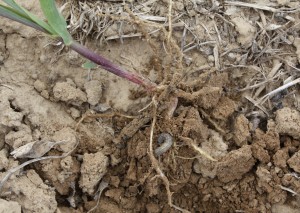As we approach corn planting time, I’ve had several questions related to cutworm management and/or the use of in-furrow insecticides. I’ve written about this subject before (https://news.utcrops.com/2015/03/is-it-too-early-to-think-about-cutworms/).
Although cutworms are not a common problem on most acres, they can sneak up on you. The suggested treatment threshold for cutworms is when 5% or more of plants are damaged or 2 or more larvae are found per 100 plants. However, I often recommend a preventative application of a pyrethroid insecticide within a week of planting, and preferably the day or week following planting. It’s hard to get an early burndown in corn, and I especially recommend this when green vegetation, including cover crops, persisted within the field within two weeks of planting (thus allowing a green bridge for cutworms to survive).

Some Bt corn technologies work pretty well at controlling small cutworms. Examples include Herculex, SmartStax, Optimum TRIsect, Optimum Leptra, and Viptera. If you’ve had nothing but dead vegetation present for two or more weeks prior to planting, it is unlikely you will have large cutworms in the field, and the above Bt technologies should hold-up to subsequent infestations of cutworms. There is a rating of how well different BT corn technologies control cutworm in UT’s insect control recommendations for corn.
The seed treatments may provide some control of cutworms, particularly Poncho (clothianidin) at the 1250 rate. But seed treatments by themselves will not hold up to serious cutworm infestations. This has some folks asking if they should apply in-furrow insecticides. This is a common practice for those running pop-up fertilizers, where they include a pyrethroid insecticide with the starter. Capture LFR is one option, but other pyrethroid insecticides are labeled for in-furrow application in field corn. Base seed treatments and rates vary by the seed company. The first thing you need to know is what insecticide seed treatment is on your corn. Did you have Cruiser (thiamethoxam) or Poncho (clothianidin) and at what rate (250, 500, 1250)? In-furrow pyrethroid insecticides will definitely help prevent cutworm injury, and it can also beef-up control of other pests not well controlled by the standard seed treatment rates (e.g., sugarcane beetle or heavy wireworm or billbug infestations). However, the potential benefit of using in-furrow insecticides goes down as seed treatment rates go up.
Hey, it’s insect control. It is hard to predict exactly when going the extra mile will pay off. Below are some scenarios where I would definitely recommend taking precautions above base seed treatments at the 250 rates (e.g., Poncho 250, Cruiser 250, PPST 250).
- Late burndown of no-till fields – These are where herbicide was not applied until the 2-3 weeks prior to planting. Apply a pyrethroid insecticide within a week of planting. If you are set-up to run a pop-up fertilizer, this is a great opportunity to apply the pyrethroid insecticide in this manner and get some extra potential benefit on below-ground pests.
- There was a cover crop you didn’t kill until near planting – plan ahead and order premium seed treatments (500 rates of higher) or use in-furrow insecticide.
- New production fields (e.g., coming our of CRP, pasture, or were fallow) – ALWAYS use highest seed treatment rates OR use an in-furrow insecticide. For fields coming out of Bermudagrass, use Poncho 1250 or supplement with an in-furrow insecticide.

